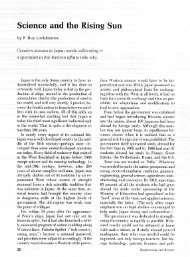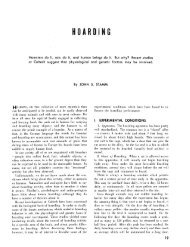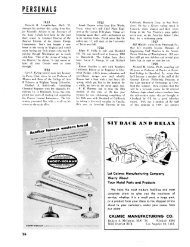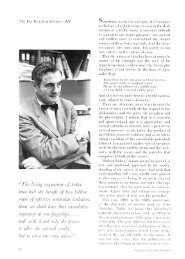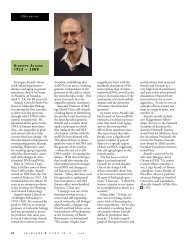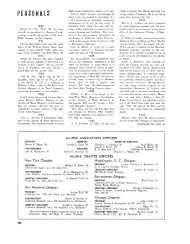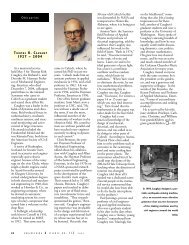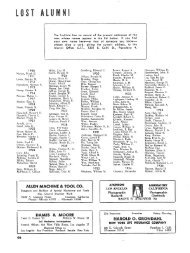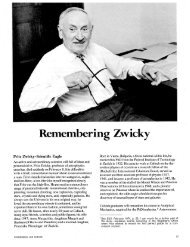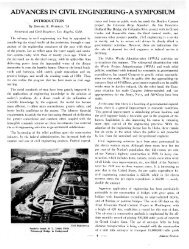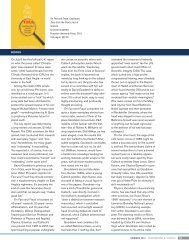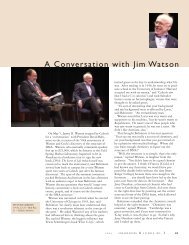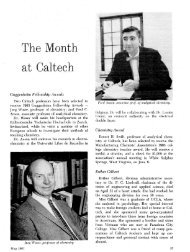Rhumba Run—Part 1 - Engineering & Science
Rhumba Run—Part 1 - Engineering & Science
Rhumba Run—Part 1 - Engineering & Science
Create successful ePaper yourself
Turn your PDF publications into a flip-book with our unique Google optimized e-Paper software.
N<br />
- \<br />
THE P.uvM6A RUM TO 8UE.NOS AIREs.<br />
0THE.R AIR ROUTES - W E ARGENTINE AND CMILE~<br />
Sketch map, Bolivia and the <strong>Rhumba</strong> Run.<br />
RHUMBA RUN<br />
Pa* I<br />
By BRADLEY YOUNG<br />
EXT Monday morning promptly at 5:30 a.m. a<br />
loaded DC-3 transport will pull away from the<br />
ramp at Lima, Peru. Under a low overcast the<br />
air is clear and a little cold. Eastward the coming day-<br />
break lies as a thin, faint line of light above the hills.<br />
Away from the platform glare, red and green wing-tip<br />
running lights are the only part of the plane visible as<br />
it turns into the far end of the runway. In the cockpit<br />
the captain eases the throttles forward, starting his engine<br />
check. Propellers full low pitch, mixture rich, car-<br />
buretor air cold, cowl flaps trail, and the super-chargers<br />
whirling 18,000 times a minute to cram their load into<br />
the cylinders. The engines idle back a moment, then<br />
break to a full-bodied roar. Twenty seconds later the<br />
plane hurtles the low adobe fence at the south boundary<br />
of the field and is off. Back under the tail the lights<br />
of San Lorenzo Island and the harbor at Callao drop<br />
away and rapidly disappear. The pilot climbs steadily<br />
and prepares to go on instruments as he enters the solid<br />
overcast. Seventy miles south of Lima the plane breaks<br />
through and is on top of the clouds at 9,000 feet. In<br />
a short time the sun shoulders its way above the<br />
towering rock wall of the Andes that parallels the<br />
course. Passengers draw their window curtains against<br />
the glare, stretch, and turn to the early morning edition<br />
of the "Comercio." One of the most remarkable flights<br />
to form a part of modern transport aviation is well under<br />
way. It is a flight that cannot be forced into the com-<br />
monplace even by the monotony of day-in and day-out<br />
repetition. Its beginning lies back in aviation develop-<br />
ments started more than 18 years ago. Some of the<br />
reasons for its more unusual features are rooted deeply<br />
in the wild, rough geography of the continent, others<br />
lie in customs that have grown up since the beginning of<br />
South America as a vast crown colony of Spain.<br />
As in other professions the men that fly this route have<br />
a marked lack of reverence for the work nearest at hand.<br />
Put a "Fast Express" on the company's schedules, de-<br />
scribe it as such in travel folders, and the pilots promptly<br />
dub it the "Gee Whizzer." In the same way the "Trans-<br />
continental" of the timetables has been known since its<br />
start as the "<strong>Rhumba</strong> Run" to those responsible for its<br />
execution.<br />
ENGINEERING AND SCIENCE MONTHLY
Starting in Lima the <strong>Rhumba</strong> Run follows the barren.<br />
arid coast of southern Peru to the Chilean border town<br />
of Arica. Climbing out of Arica the pilot slips on an<br />
oxygen mask, winds open the valve, and heads eastward<br />
toward the high Trans-Andean passes leading to Bolivia.<br />
The purser comes forward and soon oxygen is also hiss-<br />
ing gently through supply lines to the passenger cabin.<br />
Beyond the Andean passes the ground widens to a high<br />
tableland. Parsing over this and on eastward the plane<br />
cuts a corner of Lake Titicaca. Beneath, flocks of pink<br />
flamingoes move on diagonal tracks. Their wings beat<br />
the thin air rapidly as if trying to catch up with their<br />
long outthrust necks. Farther below some Indians move<br />
the hig reed sails on their balsa boats and don't even<br />
look up as the plane passes. With the lake behind, the<br />
first ston in Bolivia is made at La Paz. From La Paz<br />
the route swings southeast to Oruro and Cochabamba.<br />
Overnigliting at this point the plane again leaves on<br />
daybreak for Santa Cruz to the east. Beyond Santa<br />
Cruz the line saw-tooths back and forth to take in a num-<br />
ber of smaller towns from Conception to Robore and<br />
Puerto Suarez. Ten minutes after taking off from Puerto<br />
Suarez the pilot noses into his approach glide, calls for<br />
the flaps and gear down, and lands at Corumbh, Brazil,<br />
in the very heart of South<br />
America.<br />
Corumbh is a small, quiet town<br />
and a pleasant place to stop for<br />
the night. After dark the stars<br />
burn with a winking yellow light<br />
in a sky of tropical velvety black-<br />
ness. Whole families sit at little<br />
sidewalk tables in front of the Bar<br />
Arnericano. They speak Portu-<br />
guese in low tones punctuated<br />
with occasional laughter. Ming-<br />
ling with this are the river sounds<br />
of the Paraguay as it flows past<br />
the cliffs at the end of the street.<br />
Misnamed. the Bar Arnericano is<br />
really an unsophisticated ice cream<br />
parlor. If you ever make it, ask<br />
the waiter for a tall glass with<br />
two scoops of ice cream and a bot-<br />
tle of chilled Guaranh. This last<br />
is made from a rich, full-flavored<br />
Brazilian fruit of the same name.<br />
Pour the Guaranh over the ice<br />
cream. After the heat of a long<br />
day's flight it makes a better soda<br />
than any ever set on the counter<br />
of the corner drug store at home.<br />
Although it begins in Peru and<br />
ends by joining Panair do Brad<br />
in Corumbh, the <strong>Rhumba</strong> Run has<br />
its main sweep over Bolivia. In a<br />
space about a sixth as large as the<br />
United States. Bolivia possesses a<br />
greater diversity in climate and<br />
geography than any other area<br />
three times its size on earth.<br />
Roughly the country can be di-<br />
vided into three sections. To the<br />
southwer-t lies the great Andean<br />
Altiplano. This vast plateau is<br />
more than two miles above sea<br />
level. Its rim is hound Ly great<br />
serrated ridges of the Cordillera<br />
that rise another mile and a half<br />
above the plateau floor. In this<br />
region is located most of the Western Hemisphere's tin,<br />
now vitally needed for the defense of the Allies. The<br />
quantities that exist here of manganese, chrome, ore,<br />
wolframite, and other minerals now coming out in a<br />
growing stream have not been more than guessed at.<br />
Also in the same area on the south shores of Lake Titi-<br />
caca lie the ruins of Tiahuanaco. Locked in a high bleak<br />
wilderness of rock, they may mark the birthplace of<br />
civilization in the western world. More surely they<br />
mark the beginnings of civilization in South America and<br />
represent a race of people gone long before the Incas.<br />
To the north and east of the Altiplano are the Depart-<br />
ments of the Pando and the Beni. This region is a land<br />
of mahogany, native almonds, dye woods, and high grade<br />
rubber. Farms of cotton, corn, and semi-tropical fruits<br />
spot the river banks. The highways between these patches<br />
are the rivers themselves, floating a strange collection of<br />
boats. Loads of vegetables move from place to place on<br />
balsa rafts. Some of the Indians have graceful dugout<br />
canoes hollowed from solid logs of lignum vitae. Their<br />
lines are as smooth and clean as a six-meter yacht. One<br />
farmer near Riberalta has a contraption made of six<br />
such canoes lashed together and powered by four old<br />
outboard motors. Steering a straight course and keep-<br />
August-September, 1944 Page 5
ing all four engines going at the same time is a real feat<br />
of marine engineering. Back of the river farms run wide<br />
stretches of grazing land dotted with longhorn cattle.<br />
In the southeast of Bolivia lies the Chaco. The upper<br />
part of this is mostly jungle with some more farm and<br />
gazing land. Southward the ground dries and the vege-<br />
tation thins. Near Tarija the country appears to be a<br />
waste. It's the same sort of waste that tops the world's<br />
great oil reserves from Kettlemen Hills to the Persian<br />
Gulf, for underneath are the rich Tarija and Chuquisaca<br />
petroleum deposits.<br />
BOLIVIAN AIRLINE BEGINNINGS<br />
The difficulties of ground transportation between these<br />
sections of Bolivia are immense. Twenty years ago no<br />
one had any reason to know this better than Hans<br />
Grether. Grether was a German railway engineer, oddly<br />
enough the first to conceive of an airline as a solution to<br />
Bolivia's transportation problem. In 1924, Grether<br />
managed to interest Guillermo Kyllman, the driving<br />
force in the firm of Kyllman-Bauer. This importing<br />
company had agencies in all of Bolivia's key towns,<br />
considerable influence with the banks, and definitely<br />
represented Big Business.<br />
Late in 1924, agitation was started publicly for an air-<br />
line. This was done mostly by German colonists in the<br />
vicinity of Santa Cruz and Cochabamba. These colonists<br />
started a collection for purchasing a plane to be pre-<br />
sented to the Government on the centenary of Bolivia's<br />
Independence from Spain. The idea was that this plane,<br />
owned by the Government, would be operated to furnish<br />
a commercial air transport service. The plane chosen<br />
was a German Junkers and the factory sent Walter Jas-<br />
tram from the Junkers Technical Mission in Argentina<br />
to Bolivia to carry out the preliminary spade work in<br />
the selection of routes, etc. With this done the colonists<br />
deemed the time ripe and put in their order for the first<br />
plane, a single-motored affair carrying four passengers<br />
and a crew of two. Named El Oriente by the colonists,<br />
the plane was one of the Junkers Company's most famous<br />
models. As far back as 1919 a group of these all-metal<br />
low-wing monoplanes had been sent to the States where<br />
they established a number of flight records and carried<br />
part of the early airmail.<br />
El Oriente finally arrived in Cochabamba during July<br />
of 1925 after a long trip by boat and rail from Germany.<br />
As pilot the Junkers Company sent along Willy Neuen-<br />
Page 6<br />
AT LEFT:<br />
Native balsa boats<br />
500-foot high Lake<br />
at the northwestern<br />
the Altiplano.<br />
on 12,-<br />
Titicaca,<br />
edge of<br />
hofen who made the first flight on August 6 between<br />
Cochabamba and the town of Sucre. In a short period<br />
a number of flights were made to Potosi, Oruro, and<br />
Santa Cruz for the purpose of stirring up interest in the<br />
new venture. On August 16 the plane was formally pre-<br />
sented to the Bolivian Government by the colonists as<br />
originally ~lanned. There was quite a ceremony. The<br />
railway had aided by shipping the plane free of charge<br />
from Arica to Cochabamba. The Ministerio de Fomento<br />
had aided in securing gasoline. The President of the<br />
Republic was named Padrino or Godfather to the enter-<br />
prise, and after the Bishop had blessed the lane with a<br />
liberal sprinkling of holy water everyone was very<br />
cheerful. Guillermo Kyllman made a fine presentation<br />
speech and indicated that the first route was to be be-<br />
tween Cochabamba and Santa Cruz. This was the first<br />
portion of what is now the <strong>Rhumba</strong> Run. The only con-<br />
cerned person not present at the ceremonies was Jastram.<br />
A bad case of soroche or altitude sickness was enough<br />
to cause him to lose all interest in the proceedings. The<br />
first official flight was made late in September by Pilot<br />
Neuenhofen, with a mechanic, and some Government<br />
officials. They made the trip in a fast hour and 45 min-<br />
utes, only 10 minutes slower than the scheduled time<br />
today. By surface means it still takes two weeks to<br />
cover the same ground in good weather, and as long as<br />
two months when the weather is bad, as it often is. This<br />
new airline was to be a real aid to Bolivian progress.<br />
OTHER SOUTH AMERICAN BEGINNINGS<br />
At the same time developments were getting under<br />
way in Bolivia other South American skyways were being<br />
opened. Junkers had already sent a commercial mission<br />
to Argentina. In 1922 a similar mission was sent to the<br />
Central American countries. Gomez, "iron dictator" of<br />
Venezuela, had been approached for a franchise there.<br />
In Colombia the German-controlled airline Scadta was<br />
well underway. Having its start in 1919 as one of the<br />
world's first commercial airlines, this organization was<br />
to become particularly strong. In a few years it had<br />
mushroomed to the point where the Colombians could<br />
claim more miles of airline per inhabitant than any other<br />
country on the globe. In Brazil, Chile, and other South<br />
American countries the story was the same. The German<br />
Junkers Company was not the only one at work. Aero<br />
Postale, later to become famed as Air France, was trying<br />
for a real foothold on this new ground.<br />
ENGINEERING AND SCIENCE MONTHLY
There were American interests too. The year 1926<br />
found Juan Trippe resigning from his newly-formed<br />
Colonial Air Transport Company. The backing bankers<br />
couldn't see anything beyond their 200-mile run from<br />
Boston to New York. In 1927 Trippe started the fore-<br />
runner of Pan American Airways with a one-plane one-<br />
hop airline running from Key West to Havana. Four-<br />
teen years later this same line had grown to a 90,000-<br />
mile system serving hundreds of cities in more than 60<br />
countries.<br />
In Peru there was the beginning of an airline develop-<br />
ment that would later touch Pan American and the<br />
Junkers interests mightily. Peru, for all its mineral<br />
wealth, has largely an agrarian economy. The backbone<br />
of this economy is formed by thousands of irrigated<br />
acres of fine long-staple cotton spread up and down the<br />
dry Peruvian coast. With the cotton was the inevitable<br />
boll weevil. Growers were just 'beginning to find that a<br />
most successful way to combat this pest was by airplane<br />
dusting. In 1926 the old Huff-Daland Company special-<br />
izing in this work sent a young man to Peru as their<br />
general manager by the name of Harold Harris. He<br />
was more than manager. He was chief pilot, mainstay<br />
of the mechanical staff, purchasing agent, comptroller,<br />
bookkeeping supervisor, and general fixer-upper. His<br />
qualifications were an engineering degree from the Cali-<br />
fornia Institute of Technology, flight time on the Italian<br />
front in World War I. and some harrowing years as test<br />
pilot for the United States Army. Dusting cotton in a<br />
place as remote as Peru wasn't too easy even with this<br />
excellent background. In addition to the dangers nat-<br />
urally incident to the type of flying involved there was<br />
the problem of equipment maintenance. Break a plane<br />
or engine part and the crop, the small portion the<br />
boll weevil had left, might well be harvested before a<br />
replacement piece could arrive. In the succinct words<br />
of Manager Harris himself: "It was hell." Nothing<br />
could make the desirability of an airline linking the<br />
Americas more apparent than a few of these occurrences.<br />
Harris worked on the idea. He landed in New York in<br />
1927 and went at once to Richard Hoyt. part owner of<br />
the cotton dusting concern and executive in Hayden<br />
Stone and Company, old line New York bankers. Hoyt<br />
was also a friend of Juan Trippe and of the heads of<br />
W. R. Grace and Company. Started years ago by an<br />
Irish ship's chandler, Casa Grace now had a finger in<br />
every business pie on South America's west coast. They<br />
dealt in everything from copper mines to cotton, from<br />
rum and molasses to Panama hats. To them at the time<br />
an airline was just another small sized pie, but a pie<br />
they could not afford to keep their fingers out of. The<br />
final outcome then of the Harris-Hoyt-Trippe conferences<br />
was Pan American-Grace Airways or Panagra. Its first<br />
AT RIGHT:<br />
Views around the airports on the <strong>Rhumba</strong> Run: Top<br />
view-getting ready for the take-off at Santa Cruz.<br />
Second view-servicing a DC-3 on the Run. In the<br />
background is a Junkers 52. Third view shows a<br />
crowd of airport bystanders. Lower view-Panagra<br />
plane outside the Cochabamba hangar, high on the<br />
Altiplano.<br />
August-September, 1944
Church bells at La Paz.<br />
flight, operating then as Peruvian Airways, was made in<br />
September; 1928, from Lima north to Talara. The com-<br />
pany's only plane was a Wright Whirlwind-engined Fair-<br />
child about as large as the family sedan.<br />
By this time the Bolivian Junkers concern had become<br />
known as Lloyd Aero Boliviano, or Lab. No one seemed<br />
to know just how the name chosen was decided upon.<br />
There was no connection existing with the German Lloyd<br />
Shipping Company. The name of this firm was well<br />
known and carried great weight, however. It is probable<br />
that the word Lloyd was picked for the airline due to<br />
its connotation of large enterprise.<br />
HEMISPHERE DEFENSE<br />
Then, Panagra and Lab were as remote from each<br />
other as any two airlines could be. Thirteen years later<br />
the desire of the American Republics to transform hemi-<br />
sphere defense from a dinner topic to a working project<br />
brought a change. Axis-controlled airlines and those<br />
owned by North and South American interests were<br />
brought squarely against each other. The cause was not<br />
normal competition but something far deeper and more<br />
fundamental. Right from the start American airlines<br />
had stuck strictly to the air transportation business. Axis<br />
subsidized airlines had not. In Colombia ranking Luft-<br />
waffe flight officers were brought from Germany for<br />
familiarization training with Scadta. The Scadta routes<br />
passed within 250 miles of the Panama Canal Zone. The<br />
volume of airline meteorological information sent to<br />
Germany from Colombia and other countries indicated<br />
that the recipients had more than an academic interest<br />
in South America's weather. At what were the Nazis<br />
aiming? They were shooting for more than the profits<br />
to be gained in hauling air passengers for hire. At Dakar<br />
the Axis Powers were only a little more than 1600 miles<br />
from Natal on South America's hump. This is much<br />
nearer than the Japs were to Pearl Harbor. At Natal a<br />
Nazi toe-hold might be much more worth the effort. A<br />
network of strategically placed airports and routes and<br />
a group of experienced pilots to fly them would be of<br />
inestimable value in an offense against the Western Hemi-<br />
sphere. The Nazis have known this for years. The<br />
Americans caught on too, but not so quickly. It took a<br />
few things like the Belmonte incident to wake them up.<br />
On June 9 a year ago Major Belmonte, the Bolivian<br />
Air Attache to Germany, mailed a letter to German Min-<br />
ister Wendler in La Paz. The letter, which was inter-<br />
cepted, read as follows: "We have received all maps<br />
showing the most favorable spots for landing. These<br />
show me once more that you and your staff are doing<br />
excellent preparation for the realization of o'ur plan in<br />
favor of Bolivia . . . With the victory of the German<br />
Reich, Bolivia will need only work and discipline. . . . I<br />
will fly to Brazil upon your advice and take Cochabamba<br />
and Santa Cruz, where I have good friends." In Bolivia<br />
the present governmental regime and the large majority<br />
of the lesser citizens feel very strongly and very right-<br />
fully about a Bolivia by and for Bolivians. This con-<br />
vinced them that Senor Belmonte had held a one-man<br />
election and elevated himself to the position of Fuehrer<br />
against the coming of der Tag. Probably one of the<br />
least things it did was to reaffirm the belief of President<br />
Peiiaranda and his ministers that government action in<br />
taking over Lab a month earlier had been in Bolivia's<br />
best interests. Presumably Belmonte, now very much<br />
a persona non grata at home, is still cooling his heels in<br />
Germany awaiting victory of the Third Reich.<br />
If a Nazi thrust had come at South America, the fields<br />
and routes for which they had such plans would no<br />
doubt have been used against them. Bombers based in<br />
the interior would form strong backing forces for units<br />
flying from fields farther to the east in other republics.<br />
These planes could sweep South America's coast from<br />
the Orinoco to Cape Horn. Bolivia is a vast natural<br />
fortress for such an operation. Its front is protected by<br />
a million square miles of jungle. In a place where even<br />
the local boys get lost, no invader in tennis shoes is<br />
liable to walk through. Bolivia's railroad connections<br />
to the west coast ports of Antofagasta and Arica, and<br />
airline connections to the United States form an excel-<br />
lent back-door line of supply. Certainly at the start and<br />
in the middle years no one could foresee such a result<br />
from South American airline beginnings.<br />
LAB-THE MIDDLE HISTORY<br />
After its first flight in 1925 the progress of Lloyd<br />
Aero Boliviano was rapid. Bolivia recognized Lab<br />
through a supreme government decree and was induced<br />
to establish an annual franchise of 70,000 Bolivianos for<br />
a mail and cargo service. They also granted 130,000<br />
Bolivianos to be put up with money of the accionistas<br />
or stockholders for the purchase of three more planes.<br />
Jastram at this time was ordered by Junkers to assume<br />
the technical directorship of Lab and make plans for<br />
extending its services. After a meeting of the Lab direc-<br />
tors, the services of Jastram were accepted and he was<br />
Page 8 ENGINEERING AND SCIENCE MONTHLY
dppoii'led general manager. His work at the time wasn't<br />
made any easier by the loss of his best pilot, the man<br />
who had carried out all the company's first flights. Neu-<br />
enhofen quit. He had been a test pilot for Junkers in<br />
Dessau before coming to Bolivia. In those days such d<br />
job couldn't have been much of a sinecure. Six months'<br />
flying over all sorts of Bolivian terrain in si~~gje-<br />
engincd aircraft had convinced him however that the<br />
test pilot's job was the lesser of two evils. He returned<br />
to Germany and Junkers, later establishing a number of<br />
world's flight records. Jastram made plans for extending<br />
the airline into the Beni country but never got a chance<br />
to carry them out as he was removed from managership. -<br />
His successor was an amazing individual, Herman<br />
Schroth. This gentleman was the sort whose story is<br />
never completely told by the bare records on the hooks.<br />
The author first heard of Schroth's adventures from Ken<br />
Schlicher over a salteiia in Cochabamba's Plaza Bar.<br />
Until 1941 Schlicher, of Pennsylvania Dutch descent<br />
from around Harrisburg, was ihe only United States citizen<br />
employed by Lab. He was hired by Schroth in 1935<br />
to head the Lab Communications Department. Schlicher's<br />
qualifications for his new job were a very considerable<br />
knowledge of radio and an equally important ability to<br />
speak fluent German.<br />
As the sultefias in the Plaza Bar are large and excellent,<br />
the Schroth story was drawn out in considerable<br />
detail. For the uninitiated, a saltefia is a semicircular<br />
pouch of hrown flaky crust with a filling that defies exact<br />
translation from Spanish into English. A close approximation<br />
could be obtained by mixing a bowl of chili, the<br />
filling from a mince pie, and a New England boiled<br />
dinner. The end result is surprisingly good.<br />
As the story goes, Schroth came to Junkers and Lab<br />
with the background of a 'technical education from the<br />
University of Stuttgart, two years in the German Naval<br />
Air Service, and a short time spent in the Heinkel works<br />
at Warnemuende. He was quite a pilot, and in 1926 flew<br />
a Junkers from Germany to South Africa, being the first<br />
man to cross the Mediterranean by air. In 1927 Schroth<br />
assumed full managership of Lab. He also was chief<br />
pilot and held ex officio the job of genera1 purchasing<br />
agent. This was a large order for a young man of 27.<br />
At the same time he was a representative and salesman on<br />
commission for Junkers. It was this last combination of<br />
salesman on one side of the fence and purchasing agent<br />
on the other that got him into eventual trouble. Still<br />
later this trouble was to have its part in causing the<br />
Nazis to lose their hold on Lab.<br />
From 1927 until 1932 the expansion of Lab under the<br />
leadership of Schrotli was rapid, if not too sound. In<br />
the north the rich Beni country was opened up. What<br />
had been a 45-day expeditionary trip from Cocliabamba<br />
to Trinidad became an easy hour and a half ride.<br />
Cheese, hides, chocolate, the sun-dried and salted beef<br />
the Indians call charqui, and a host of other things<br />
began to move to the markets at Cochabamba, Cliza, and<br />
La Paz. Out also came an occasional sick or injured<br />
person who might otherwise have died from lack of hospitalization<br />
in the interior. Moving in from Cochabamba<br />
to Trinidad, Todos Santos, and Cobija were quantities<br />
of salt, kerosene, sewing machines, and a hundred<br />
different commodities. Frequent among these shipments<br />
then. as todai. ivere dozens of sacks of chufio. a tvne of<br />
, , . 4 .<br />
small Andean potato. These potatoes, grown only on<br />
the higher slopes of the Sierra, are processed by an<br />
alternate soaking in the icy mountain streams and then<br />
freezing. The final product looks like something normally<br />
used to feed a concrete mixer, but not a liuman being. As<br />
might be expected, their processing make5 them practically<br />
indestructible. This is important in districts like<br />
the Beni where the hot damp weather and lack of refrigeration<br />
cause rapid spoiling of fresher vegetables.<br />
Pushing in another direction the company began to fly<br />
farther eastward over the wide llanos or grate lands that<br />
lay fieyond Santa Cruz. Aerial navigation here was ditficult.<br />
much like the problem of traversing the ocean.<br />
Ahead. out of the haze. the horizon comes up hour after<br />
hour. flat and without landmark. Heneath. every passing<br />
kilometer of around appears like ekcry other one, a<br />
i-un-dappled broadloom carpet of green trees and undergrowth.<br />
The air is hot eien at 10.000 feet. The cockpit<br />
fills with a mixed odor of auto-pilot oil, lacquer, and<br />
Ii~draulir system fluid that the heat intensifies. Except<br />
in the pa>senger cabin where regulations stipulate otherwise<br />
the crew pushes along with rolled shirt sleeves and<br />
opened collars. During most of the year a large part<br />
of the land beneath lies flooded and impassable. This<br />
isolates the slightly higher planes of fertile well-drained<br />
soil thai might he tilled or used for raising cattle. Except<br />
by air such spots lie as remote as the mountains<br />
of Tibet. nith resources that might never be realized. In<br />
addition to forming an opening wcdgc in this new country<br />
the lafet extensions gave Lab and Bolhia a connection<br />
with Rio and the entire east coa



